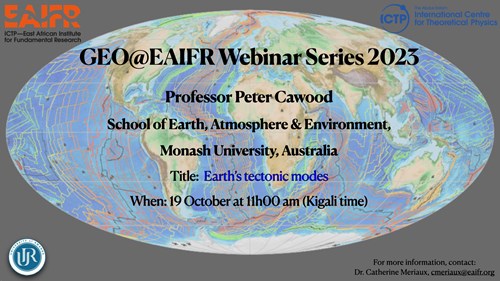ICTP-East African Institute for Fundamental Research
KIST2 Building CST
Nyarugenge Campus
University of Rwanda
Kigali, Rwanda
GEO@EAIFR Webinar Series 2023
Professor Peter Cawood from the School of Earth, Atmosphere & Environment at Monash University (Australia) will discuss the evolution of the Earth from a tectonic point of view.

The East African Institute for Fundamental Research (EAIFR) and the International Centre for Theoretical Physics (ICTP) wish to inform those who may be interested of a GEO@EAIFR webinar. This seminar will take place on October 19, 2023 and will be broadcast live on ZOOM. It will also be recorded and later posted on the ICTP-EAIFR YouTube channel, where one can find the previous recorded GEO@EAIFR webinars. Below all the details:
Speaker: Professor Peter Cawood, School of Earth, Atmosphere & Environment, Monash University, Melbourne, VIC 3800, Australia.
Email: peter.cawood@monash.edu
Title: Earth’s tectonic modes
When: October 19, 2023 at 11:00 am (Kigali time).
Register in advance for this meeting by clicking here.
All are very welcome.

Biography: Peter Cawood is an Australian Research Council Laureate Fellow at Monash University. He undertook his PhD ast the University of Sydney and has previously held positions in New Zealand, Canada, Scotland and Australia. His research is concerned with the evolution of the continental crust and the insights this provide into Earth processes, including resources. Major contributions include: secular changes in the rock record and implications for defining stages of Earth evolution; the time for initiation of plate tectonics on the Earth and implications for continental crust generation; how the supercontinent cycle has biased the rock record; and the application of microanalyitical techniques to provenance studies.
Abstract: The Earth has evolved into a habitable planet through ongoing and complex cycling. Decades of field studies, geochemical analyses and computational approaches to integrate data into feasible geodynamic models reveal that Earth’s evolution was not linear but evolved in discrete phases. The timing of changes between these phases, their loci within Earth’s crust or between discrete cratonic terranes, and most importantly the drivers or tipping point for these changes, remain elusive.
Integrating the record from the continental archive with knowledge of the ongoing cooling of the mantle and lithospheric rheology (parametrized for its evolving thermal state) allows us to determine that a number of different tectonic modes operated through the early history of the Earth. The temporal boundaries between these proposed different phases in tectonic mode are approximate, transitional, and correspond with the first recording of a key feature of that phase.
Initial accretion and the moon forming impact resulted in a proto-Earth phase (ca. 4.57-4.45 Ga) likely characterized by a magma ocean. Its solidification produced the primitive Earth lithosphere that extended from ca. 4.45-3.80 Ga, which based on the very minor fragments preserved in younger cratons provides evidence for intra-lithospheric reworking, but which also likely involved intermittent and partial recycling of the lid through mantle overturn and meteoritic impacts. Evidence for craton formation and stabilization during the primitive (ca. 3.8 Ga to 3.2 Ga), and juvenile (ca. 3.2 Ga to 2.5 Ga) phases of Earth evolution likely reflects some degree of coupling between the convecting mantle and a lithosphere initially weak enough to favour an internally deformable, squishy-lid behaviour. These regions of deformable lithosphere likely oscillated spatially and temporally with regions of more rigid, plate like, behaviour leading to a transition to global plate tectonics by the end of the Archean (ca. 2.5 Ga). Evidence for assembly of rigid cratonic blocks in the late Archean along with their subsequent rifting and breakup followed by their reassembly along major linear orogenic belts in the Paleoproterozoic marks the clear inception of the supercontinent cycle in response to a plate tectonic framework of oceans opening and closing.
Since solidification of the magma ocean early in Earth history, the available record suggests some degree of mantle-lithosphere coupling. The development and stabilization of cratons from 3.8-2.5 Ga provides evidence for the progressive development of rigid lithosphere and represents the inexorable precursor to the development of plate tectonics. Evidence for assembly of rigid cratonic blocks in the late Archean along with their subsequent rifting and breakup followed by their reassembly along major linear orogenic belts in the late Paleoproterozoic marks the clear inception of the supercontinent cycle in response to a plate tectonic framework of oceans opening and closing.
P.A. Cawood et al., 2022, Secular evolution of continents and the Earth system. Reviews of Geophysics, v. 60, e2022RG000789.



